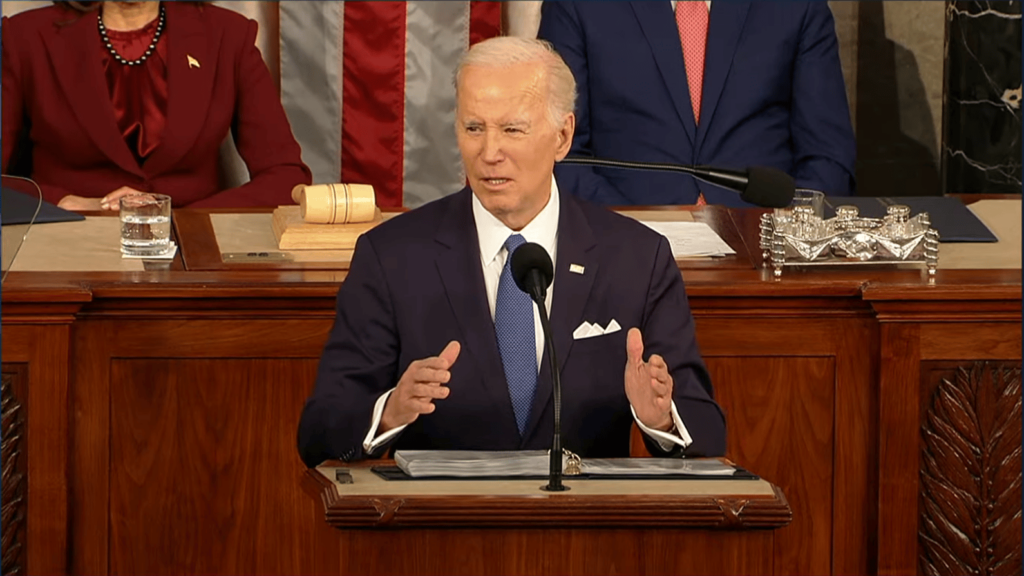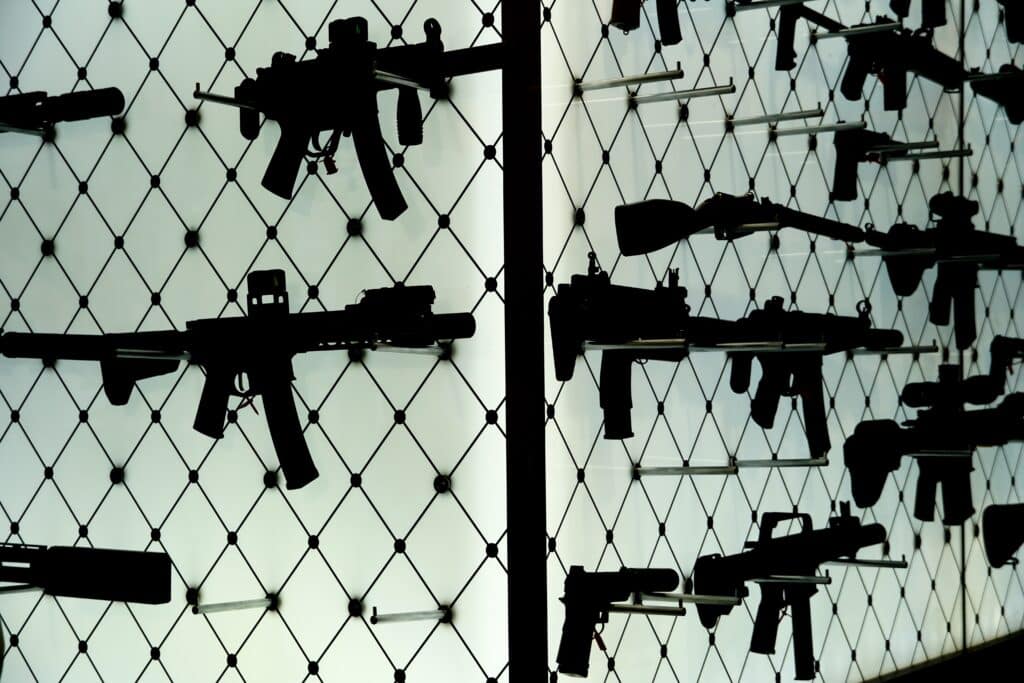The pistol brace ban, President Joe Biden’s most significant gun restriction to date, has had a hard go of it since it was finalized.
First, most Americans simply refused to comply. Then came the early court orders blocking enforcement. Then, the Supreme Court struck down the bump stock ban it was modeled after. Now, it looks like it probably won’t survive the numerous court challenges across several federal districts.
But all of that begs the question, will any of Biden’s restrictions last? I do my best to predict where this is heading.
Contributing Writer Jake Fogleman also looks at the best chance gun-rights advocates have to get an “assault weapons” ban in front of SCOTUS. He reasons through the factors that would and wouldn’t entice the Court to hear the case.
Plus, we’ve got pistol brace inventor Alex Bosco on the podcast to discuss his company’s recent court victory over the ban.

Analysis: Will Any Biden Gun Restrictions Survive the Courts? [Member Exclusive]
By Stephen Gutowski
The Biden Administration’s gun record has hit another snag.
Last Friday, a three-judge panel on the Eighth Circuit Court of Appeals ruled against the administration’s reclassification of pistol-brace-equipped firearms as unregistered short-barrel rifles. It was just the latest in a series of setbacks for President Joe Biden’s aggressive policy of using federal rulemaking to unilaterally expand gun restrictions. It also extended those court losses to a new federal circuit.
The news casts doubt on Biden’s approach and that of his successor for the Democratic Presidential nomination, as Vice President Kamala Harris previously advocated for an even broader push for executive action on guns. At this point, the more relevant question is less whether Biden or Harris could further push the boundaries of executive gun action and more whether any of the restrictions they’ve already implemented will stand up to constitutional scrutiny.
This became a realistic question in the wake of the Supreme Court’s decision in Cargill v. Garland, where the majority actually struck down a Trump-era restriction. The Court found former President Donald Trump’s attempt to use federal rulemaking to ban bump stocks was unlawful back in June. The Eighth Circuit panel’s ruling is now the first to use that precedent in examining President Biden’s attempt to follow the same path to a ban on a different kind of firearm accessory.
In FRAC v. Garland, the panel directly cited Cargill when deciding whether or not the ATF’s brace rule was ripe for a challenge under the Administrative Procedures Act (APA).
“The Supreme Court clearly treated the ATF interpretive rule as a final agency action because the Court held the ATF exceeded its statutory authority and affirmed the Fifth Circuit’s judgment ‘[T]he Final Rule makes it ‘nigh impossible for a regular citizen to determine what constitutes a braced pistol, and … whether a specified braced pistol requires NFA registration,'” Judge L. Steven Grasz wrote for the majority in FRAC v. Garland. “For those reasons, the Final Rule is arbitrary and capricious.”
The panel came to the same conclusion SCOTUS did: the ATF’s attempts to re-interpret existing federal law and subject a wide swath of gun owners to potential criminal penalties qualify for judicial review. And, ultimately, the ATF’s actions were unlawful.
Biden has implemented most of his new restrictions using the same process as the bump stock ban, and they’re vulnerable to the same pitfalls as well.
His administration looked at areas of decades-old federal gun laws it considered to be gray areas and ordered the ATF to reconsider them with stricter interpretations. However, those interpretations were inherently questionable. And, much like with the bump stock ban, they often contradicted what the ATF had previously determined–something the Supreme Court singled out as problematic.
“For many years, the Bureau of Alcohol, Tobacco, Firearms and Explosives (ATF) took the position that semiautomatic rifles equipped with bump stocks were not machineguns under the statute,” Thomas wrote. “On more than 10 separate occasions over several administrations, ATF consistently concluded that rifles equipped with bump stocks cannot ‘automatically’ fire more than one shot ‘by a single function of the trigger.'”
Those questionable reinterpretations and the baggage of the ATF’s past positions jeopardize the Biden-era rules.
Of course, these weaknesses are why most of the Biden rules have been in legal peril basically since they were issued. Most are not even currently enforced, thanks to lower court rulings. In fact, another federal court already invalidated the brace ban.
It’s hard to imagine a scenario where the so-called ghost gun kit ban or the brace ban survives court scrutiny. The ghost gun case is already before the court, and the Eighth Circuit’s ruling provides further motivation for the justices to take it up as well. Or, at the very least, address it more directly in the ghost gun case.
There is one rule that could fare better, though. It doesn’t share the same pitfalls as the other two. And that’s the private gun sales rule.
The thing that may save the gun sales rule is the other aspect of Biden’s legacy that is likely to survive court challenges. That’s the Bipartisan Safer Communities Act, an actual piece of legislation. In addition to a bunch of funding for things like state “red flag” laws or school security, the law expands the background check for 18-to-20-year-olds into nearly a defacto waiting period, and it adds dating partners to the misdemeanor domestic violence gun ban.
Those restrictions have a much better chance of surviving than the ones implemented through pure executive action. But the law also provides some cover for the change to private gun sales regulations via executive rulemaking because it tweaks the underlying statute governing who needs a license to sell guns.
So, unlike the bump stock ban, pistol brace ban, or ghost gun kit ban, the private gun sales rule was preceded by an actual change in the law the ATF interpreted. Of course, that doesn’t necessarily mean that rule will survive. The underlying language change the Biden Administration is relying on to justify restricting private gun sales is modest, and several of the lawmakers who drafted and voted for it have already said the ATF is misinterpreting it.
Even the new gun restrictions in the Bipartisan Safer Communities Act could fail in court. After all, under the Supreme Court’s Bruen standard, the government would have to show the regulations are based in the historical tradition of gun control dating to the Founding Era. That is a stringent test that could trip up any modern gun law.
Still, as the courts work through the myriad of challenges to Biden-era gun restrictions, it’s increasingly likely the private sales rule and Bipartisan Safer Communities Act are the only ones with a realistic chance of surviving.
Podcast: Pistol Brace Inventor on His Win Over the ATF [Member Early Access]
By Stephen Gutowski
The pistol brace ban just racked up another legal loss.
A panel on the Eighth Circuit Court of Appeals ruled against the ban. That puts it in legal peril in a whole new federal circuit. And this case is the one led by the company that pioneered the accessory, SB Tactical.
That’s why we have SB Tactical Founder Alex Bosco on the show to give his reaction to the ruling. He explains why he thinks the new decision is vital for his company and industry even though another court already vacated the brace ban rule. Then, he lays out where SB Tactical and the industry plan to head from here, both in court and in the marketplace.
We also have a Member Segment where we hear from one of the people who make The Reload possible. He describes his journey from military kid to military man to gun collector and beyond. It’s always great getting to know our members!
You can listen to the show on your favorite podcasting app or by clicking here. Video of the episode is available on our YouTube channel. An auto-generated transcript is here. Reload Members get access on Sunday, as always. Everyone else can listen on Monday.
Plus, Contributing Writer Jake Fogleman and I cover new polling data showing that the Supreme Court’s recognition of public gun carry rights is more popular than ever. We also analyze the likelihood of the Supreme Court agreeing to hear an assault weapon case later this year, as well as a new Fox News poll showing voters trust Donald Trump over Kamala Harris on gun policy. We wrap up by discussing a new Eighth Circuit Court of Appeals ruling against President Biden’s pistol brace ban, New York officials opting to create gun carry permits for non-residents, and the latest instance of parents of school shooters being taken to court.

Analysis: Will This Be the Year SCOTUS Takes an ‘Assault Weapons’ Ban Case? [Member Exclusive]
By Jake Fogleman
In a recent ruling upholding Maryland’s ban on so-called assault weapons, a federal appeals court gave gun-rights advocates their best opportunity yet to entice the Supreme Court to strike down those bans nationwide. Whether the Justices are prepared to oblige them is another matter entirely.
In a divided opinion last week, the en banc Fourth Circuit Court of Appeals delivered its long-awaited judgment of Maryland’s ban on AR-15s and other semi-automatic weapons. By a ten-to-five margin, the court’s majority upheld the ban.
“The assault weapons at issue fall outside the ambit of protection offered by the Second Amendment because, in essence, they are military-style weapons designed for sustained combat operations that are ill-suited and disproportionate to the need for self-defense,” Judge Harvie Wilkinson wrote in Bianchi v. Brown.
Rather than greet the preservation of one of the movement’s longest-standing targets with dejection, some gun-rights advocates celebrated the outcome. Pro-gun attorney and legal commentator Mark Smith called the ruling “100% expected” and “excellent news for [the Second Amendment]” in a social media post.
“It should be a clear glide path to SCOTUS for them to hear an ‘assault weapon’ ban case next term (2024-25),” he reasoned.
Indeed, such optimism is not entirely unwarranted.
The Fourth Circuit’s decision is a final ruling on the merits of an assault weapon ban from an en banc federal appellate court. That means there’s simply no other legal venue left for the case to go on appeal other than to the Supreme Court. The issue of final judgments versus interlocutory appeals has been a problem for gun-rights activists of late. The Supreme Court has consistently declined to get involved in a ban case before the lower courts could reach a merits decision. Most recently, the Court rejected a Seventh Circuit case covering the Illinois assault weapon ban.
“This Court is rightly wary of taking cases in an interlocutory posture,” Justice Thomas wrote in a brief opinion appended to the Court’s denial of cert in that case.
With the new Bianchi decision, that prior hurdle has now been cleared.
Furthermore, two members of the Court’s conservative majority are already on board with reviewing hardware bans. Justice Samuel Alito noted that he would have voted to take up the Illinois gun ban case last month, and Thomas expanded his brief opinion to express his desire for the Court to address the question as soon as a more appropriate opportunity arises.
“I hope we will consider the important issues presented by these petitions after the cases reach final judgment,” he wrote. “We have never squarely addressed what types of weapons are ‘Arms’ protected by the Second Amendment.”
Thomas went even further by strongly suggesting that Illinois’ gun ban, which is similar (though not identical) to Maryland’s, is likely unconstitutional.
“If the Seventh Circuit ultimately allows Illinois to ban America’s most common civilian rifle, we can—and should—review that decision once the cases reach a final judgment,” he wrote. “The Court must not permit ‘the Seventh Circuit [to] relegat[e] the Second Amendment to a second-class right.’”
The Maryland case’s procedural history also makes it a particularly compelling case for the Court to consider taking. It was already presented to the Justices once before in 2021 after the Fourth Circuit previously upheld the state’s ban. The Supreme Court ultimately opted to grant, vacate, and remand (GVR) that decision back to the Fourth Circuit after its New York State Rifle and Pistol Association v. Bruen ruling in 2022, which created a new test for Second Amendment cases.
A three-judge panel for the Fourth Circuit reheard the case on remand in December of 2022 but stayed silent on the matter for more than a year after that. Then, earlier this January, a majority on the Fourth Circuit suddenly voted to take the case en banc without the panel ever issuing a decision. According to Judge Julius Richardson, that’s because a dissenting judge on the original three-judge panel exercised a “pocket veto” of what would have been a ruling striking down the state’s ban by not returning his section of the opinion.
“After hearing the case in December 2022, the initial panel majority reached a decision and promptly circulated a draft opinion,” Richardson wrote in a dissent from last week’s ruling. “Yet, for more than a year, no dissent was circulated. The panel thus held the proposed opinion in accordance with our custom that majority and dissenting opinions be published together. One year later, as the proposed opinion sat idle, a different panel heard arguments in United States v. Price, which also involved interpreting and applying Bruen. The Price panel quickly circulated a unanimous opinion that reached a conclusion at odds with the Bianchi majority’s year-old proposed opinion. Facing two competing proposed published opinions, the court declined to let the earlier circulated opinion control. Rather, in January 2024, we invoked the once extraordinary mechanism of an initial en banc review.”
A history of being GVR’d already suggested the Supreme Court at least had its eye on the case. That, coupled with a perception of judicial gamesmanship to scuttle the possibility of pro-gun precedent, could prompt the Justices to take the case to deter something similar from happening in the future.
At the same time, gun-rights advocates do still face some headwinds that could dash their hopes of seeing an assault weapon ban before the Court in the near future.
For starters, there’s no circuit split on the question, and there likely isn’t going to be any time soon.
As the Court of last resort, the Supreme Court generally prefers to hold off on hearing big constitutional questions until there’s an active controversy between the lower appellate courts after they have reached opposite conclusions. There are exceptions, of course, particularly when an appeals court decision blows a hole in existing federal law for a particular segment of the country. In those instances, the Justices will sometimes hear a case without a circuit split, usually at the behest of the DOJ, to whom the Court tends to grant more deference.
What makes the Bianchi decision different from those exceptions is that while assault weapon bans are of national significance, the case deals solely with a particular state law in a circuit in which Maryland is the only state with such a ban. Furthermore, the Fourth Circuit merely preserved the status quo by upholding the ban rather than inducing any new upheaval in Maryland’s legal system that might demand immediate intervention.
Additionally, it’s still not obvious that the other Justices on the Court have the same appetite as Thomas and Alito to take up a hardware ban case in the first place. Sure, Justice Kavanaugh has already demonstrated that he believes such bans are unconstitutional during his time on the D.C. Circuit in his 2011 Heller II opinion. But ruling that way when a case is already in front of you (in a dissenting opinion, no less) and voting to take one up in the first place as a member of the highest court in the land are two separate questions.
The same holds true for Justices Barrett and Roberts, who, while not obviously personally in favor of assault weapon bans, are generally perceived as being more cautious and conscious of institutional perception in the Court’s actions. They have a track record of appearing to weigh the optics of the Court’s decisions in many cases and may not want to ignite the public firestorm that would ensue from the Court raising the question of such a policy’s viability, particularly as the Court is already underwater with public opinion and subject to new partisan attacks every day.
Finally, the Court may also simply have its hands full with what it perceives to be more pressing Second Amendment and other gun-related questions in the near term.
After striking down the Trump-era bump stock ban last term, the justices are already slated to hear another case dealing with the ATF’s rulemaking later this year when they will be asked to review the agency’s “ghost gun” kit ban. Meanwhile, further decisions striking down other ATF rules continue to percolate up through the federal appellate courts and could also wind up before the Court.
Against that backdrop of regulatory gun control challenges, the Supreme Court has also been inundated with requests to address a litany of prohibited persons cases. In the aftermath of its June decision in US v. Rahimi, the question of to what extent felons have gun rights has been a particularly live issue. In the wake of Rahimi, the U.S. Department of Justice asked the Supreme Court to resolve the existing circuit split over whether certain types of felons retain their gun rights, noting in the process that felon-in-possession convictions account for nearly 12 percent of all federal criminal cases. The Court refused and instead sent the five appealed cases back down for new decisions at the appellate level last month. At least one has already been returned with the same outcome.
While it is true that the Court has shown a willingness to take an increased number of gun-related cases in short succession of late, it is also noticeably taking fewer cases overall each term. As more criminal justice system controversies arise, the justices may have little room on their plates for additional Second Amendment work.
It’s not obvious which factors will weigh heavier on the minds of the Justices. It almost never is when it comes to reading the tea leaves on potential Supreme Court cert grants. What is for certain is that gun-rights advocates currently have their best vehicle to date for getting the Court to weigh in on an assault weapon ban. That is by no means guaranteed to be enough, though.
That’s it for now.
I’ll talk to you all again soon.
Thanks,
Stephen Gutowski
Founder
The Reload







